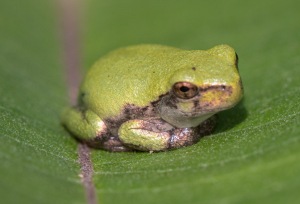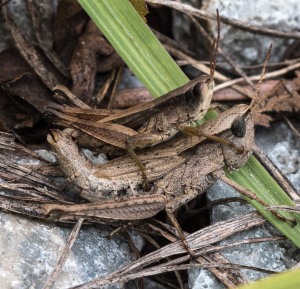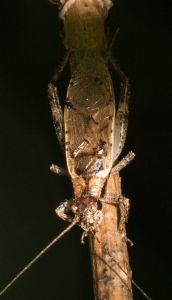by Carl Strang
For years, now, my biggest conservation concern among the singing insects has been in the wetlands. Though our historically abundant prairies in the Chicago region were diminished nearly to nothing by 19th– and 20th-century agriculture, preservation and restoration projects across the region have halted and, to a small degree, reversed that trend. The same could be said for savannas, and our forests did not suffer as much.
Wetlands, like prairies, declined thanks to agriculture, but a new challenge continues to threaten their integrity: invasive wetland plants. Four of these are especially problematic: common reed (Phragmites australis), reed canary grass (Phalaris arundinacea), hybrid cattails (Typha x glauca), and purple loosestrife (Lythrum salicaria). These plants, released from consumers and competitors, have displaced the diverse native species in a large and increasing portion of our wetland acreage. The loss of native wetland grasses, especially, appears to account for the difficulty I am experiencing in finding wetland katydids.

Reed canary grass
Two species that were here historically, I have not found at all: the delicate meadow katydid (Orchelimum delicatum), and the slender conehead (Neoconocephalus lyristes). In the past these were known to occur in four and three, respectively, of the Chicago region’s 22 counties, and I am nearly out of places to check where they might still live. The stripe-faced meadow katydid (O. concinnum), once found in 8 of the counties, appears to be down to a single population at Illinois Beach State Park.

Stripe-faced meadow katydid
Two wetland katydids are doing well. Gladiator meadow katydids (O. gladiator) and black-legged meadow katydids (O. nigripes) are tolerant of the invasive plants, and remain common in every county.
That leaves an in-between category of wetland singing insects that apparently are limited to invasives-free wetlands, and are managing to hang on in a few to several sites. Northern mole crickets (Neocurtilla hexadactyla) occur in wet prairies as well as marshes. In 2017 I added records for two more sites, one of which represented an additional county record. To date I have found them in 10 counties, and remain optimistic that I can add more populations to the inventory.
Dusky-faced meadow katydids (O. campestre) historically were ubiquitous in our marshes. To date I have found them only in marshes with minimal impact by the invasive plants. These katydids seem able to persist in relatively small wetland areas, however, and each year I have been able to add new populations to my list. In 2017 I found them in the Indiana Kankakee Sands preserve, adding Newton County to the record, and in the Tefft Savanna preserve in Jasper County, also a county record. That brings to seven the number of counties where I have found the species, but there are seven more where it once lived, but where my search has been unsuccessful. Dusky-faced meadow katydids also proved this year to be abundant in the panne wetlands at West Beach in the Indiana Dunes National Lakeshore. That was a good find, but I had hoped for delicate meadow katydids there.

Female dusky-faced meadow katydid, Tefft Savanna
Finally, this year I added a third population and county for the nimble meadow katydid (O. volantum). They were singing from arrowheads (Sagittaria sp.) mixed with cattails along Grant Creek in the Midewin National Tallgrass Prairie. That find was made from a kayak, and that is the vehicle from which further searching for the species will need to happen, as this species likes plants growing in relatively deep water. Some places which historically held nimble meadow katydids no longer have them, but several other sites remain for me to check in future years.








